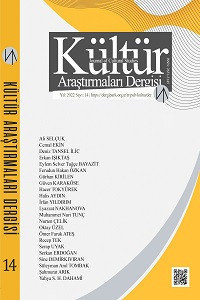DİNİ-KÜLTÜREL PERSPEKTİF VE SOL EL TABUSU: BENGALCE KONUŞAN İNSANLARIN ÜRETTİĞİ KONTROLLÜ EL HAREKETLERİNİN AÇIKLAMASI
Egemen bir sosyo-kültürel ve manevi görüngü olan din, tüm dünyada kendiliğinden gerçekleşen insan faaliyetlerini farklı şekillerde kontrol eder. Ayrıca kutsal kitapların göz ardı ettiği sosyal gelenekleri, görenekleri ve insan davranış kalıplarını ve bunlardan türetilen kuralları ve yasaları da yasaklamaktadır. Önde gelen sosyal kurumlardan biri olan din, bir toplum içindeki inananlar tarafından izlenecek farklı kodları yürürlüğe koymaktadır. Bu tür sosyal kodlar bazen psikolojik durumları, özellikle farklı bilişsel uygulamaları çok yönlü bir şekilde kısıtlar. Böylece din, insan zihnini ve sosyalleşme sürecini azami ölçüde kontrol etmek amacıyla farklı toplumsal düzenleri tanımlar ve pekiştirir. İnsanların nöro-bilişsel motor davranışlarının bir tezahürü olan jestler, dünyanın birçok yerinde bu tür kuralcı din kodları tarafından denetlenmektedir. Bengalce konuşulan bölgede, İslami kurallar ve yasalar, kamusal işlevlerde el hareketlerini, özellikle de sol elin hareketlerini çok kaba bir davranış olarak ele alır. Bu bölgedeki insanlar, bu tür dini kuralları takip etme yöntemi olarak, bu elin hareketlerini farklı sosyal ve dini faaliyetlerde çok kuvvetli bir şekilde kontrol etmektedir. Bazen, dini değerlerin ve geleneklerin baskısı nedeniyle, halka açık yerlerde yapılan sol el hareketlerinden -bir tür kendiliğinden olan bilişsel tahrik- kaçınmaları gerekir. Bu makale, hem Bengalce konuşan insanların sol el tabularının doğasını hem de sol elin jest üretimi esnasında kısıtlı zamansal ve uzamsal oranlar ile kontrollü kullanımını incelemektedir.
Anahtar Kelimeler:
sol el tabusu, tabu, jest ve biliş, sol el, bilişsel kontrol
RELIGIO-CULTURAL PERSPECTIVE AND LEFT HAND TABOO: A DESCRIPTION OF CONTROLLED HAND GESTURES PRODUCED BY BENGALI SPEAKING PEOPLE
Religion, a dominant socio-cultural as well as spiritual phenomenon, controls spontaneous human activities in different ways all over the world. It also prohibits social traditions, customs, and human behavioral patterns which are disregarded by the holy books as well as the rules and laws derived from these. As one of the leading social institutions, religion brings different codes into force to be followed by the believers within a society. Such social codes sometimes restrain their psychological states, especially different cognitive practices, in multifarious ways. Thus religion always defines and reinforces different social orders with a view to controlling, to the maximum extent, the human mind and the process of socialization. Gesture as a manifestation of neuro-cognitive motor behavior of human beings is also moderated by such prescriptive codes of religion in many parts of the world. In the Bengali-speaking area, Islamic rules and laws treat hand gestures, especially the movements of the left hand, in public functions as very rude behavior. People in this region, as a method of following such religious inscriptions, overwhelmingly control the movements of this hand in different social and religious activities. Sometimes they need to avoid publicly performed left hand gestures—a form of spontaneous cognitive incitement—due to the pressure of religious values and customs. This paper examines the nature of left hand gestural taboos of Bengali speaking people as well as very controlled usage of the left hand with limited temporal and spatial proportions while producing gestures.
Keywords:
Left Hand Taboo, Taboo, Gesture and Cognition, Left Hand, Cognitive Control,
___
- Armstrong, D. F., Stokoe, W. C. & Wilcox, S. E. (1995). Gesture and the Nature of language. Cambridge: Cambridge University Press.
- Chomsky, N. (1972). Language and Mind. New York: Harcourt Brace Jovanovich.
- Corballis, M. C. (2002). From Hand to Mouth; The Origins of Language. Princeton and Oxford: Princeton University Press.
- Duncan, S. (2001). “Perspective on the co-expressivity of speech and co-speech gestures in three languages”. In Proceedings of the 27 th Annual Meetings of the Berkeley Linguistics Society. Berkeley CA: The Berkeley Linguistic Society.
- Ekman, P. & Friesen, W. (1969). The Repertoire of Nonverbal Behavior: Categories, Origins, Usage, and Coding. Semiotica 1: 49-98.
- Goldin-Meadow, S. (2003). Hearing gesture. Cambridge MA: Harvard University Press.
- Haviland, J. B. (2000). “Pointing, gesture space and mental maps”. Language and Gesture. (Ed. McNeill, D.). Cambridge: Cambridge University Press, 13-46.
- Kendon, A. (1980). “Some considerations for a theory of language origins”. Man, 26: 199-221.
- Kendon, A. (1986). “Some reasons for studying gesture”. Semiotica, 62, ½: 3-28.
- Kita, S. & Essegbey, J. (2004). “Left-hand taboo on direction-indicating gestures in Ghana: When and why people still use left-hand gesture”. In Rector, M. et al. (eds.) Gesture. Meaning and Use. Universidade Fernando Pessoa, 301-306.
- Kita, S. (1998). “Expressing Turns at an Invisible Location in Route Direction: The Interplay of Speech and Body Movement”. In Hess-Lüttich, E. et al (eds.) Sign & Space. Raum & Zeichen. Tübingen: Gunter Narr, 160-172.
- McNeill, D. & Pedaelty, L. L. (1995). “Right Brian and Gesture”. In Emmorey, R. and Judy, S.H. (eds.) Language, Gesture and Space. New Jersey: Hillside, 63-85.
- McNeill, D. (1992). Hand and Mind. The University of Chicago Press.
- Núñez, R. & Sweetser, E. (2006). “With the future behind them: Cognitive evidence from Aymara language and gesture in the crosslinguistic comparison of spatial construal of time”. Cognitive Science, 30: 1-49.
- Posner, R. (2004). “Everyday Gesture As a Result of Reutilization”. In Rector, M. et al (eds.) Gesture. Meaning and Use. Universidade Fernando Pessoa, 217-230.
- Sweetser, E. (2007). “Looking at space to study mental spaces co-speech gesture as a crucial data source in cognitive linguistics”. In Gonzalez-Marquez, M. et al. (eds.) Methods in Cognitive Linguistics. Amsterdam/Philadelphia: John Benjamins Publishing Company, 201-224.
- ISSN: 2651-3145
- Yayın Aralığı: Yılda 4 Sayı
- Başlangıç: 2018
- Yayıncı: Mehmet Ali YOLCU
Sayıdaki Diğer Makaleler
HAREKELİ BİR MAKTEL-İ HÜSEYİN ÖRNEĞİ
KOLONYALİZMİN “GÜLERYÜZÜ”NE BAKIŞ: AHMET MİDHAT EFENDİ VE ESTETİK KOLONYALİZM SÖYLEMİ
FİLM UYARLAMALARINDA ANLATININ DÖNÜŞÜMÜ: YETİŞKİNLERE MASALLAR-PAMUK PRENSES
DÜNYA MİRASI OLMA YOLUNDA “URARTU VE OSMANLI ESKİ YERLEŞİMİ AHLAT MEZAR TAŞLARI” KÜLTÜREL MİRASI
ERKEN CUMHURİYET DÖNEMİNDE TAŞINMAZ KÜLTÜR VARLIKLARINA YÖNELİK İZLENEN POLİTİKA (1923-1938)
Ercan KARAKOÇ, Hülya UTKULUER YILDIRIM
THE TURKISH SPY: CHARLES COOPER’İN GELİBOLU HİKAYESİ
ELEKE SAZI’NDA GEÇ TUNÇ ÇAĞI'NA AİT BİR İSKİT KURGANI
EDEBİYATTAN SİNEMAYA GÖSTERGEBİLİMSEL BİR ANLAMLANDIRMA: BİR İNTİHAR ÖRNEĞİ
BOSNA ŞARKISI PİYESİ ÖRNEĞİNDE BARIŞÇIL SÖYLEMİN İNŞASINDA MÜZİĞİN İŞLEVİ
